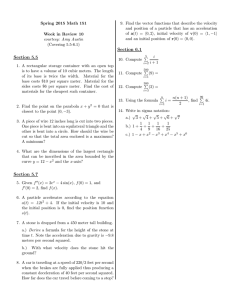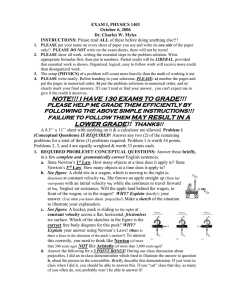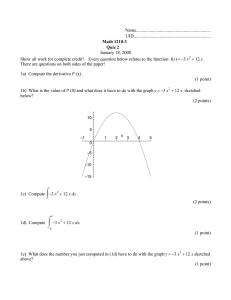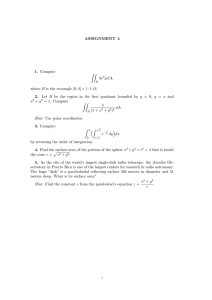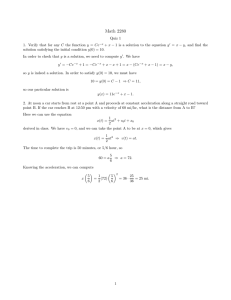EXAM I, PHYSICS 1403-002 (TT) February 17, 2005 Dr. Charles W. Myles INSTRUCTIONS:
advertisement
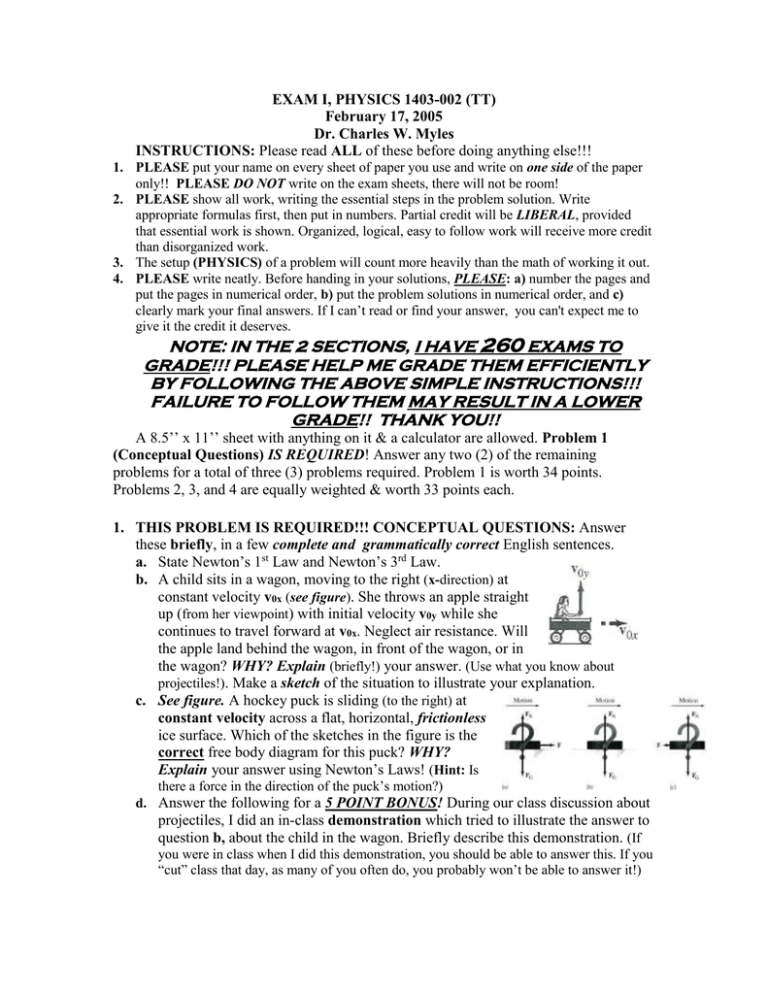
EXAM I, PHYSICS 1403-002 (TT) February 17, 2005 Dr. Charles W. Myles INSTRUCTIONS: Please read ALL of these before doing anything else!!! 1. PLEASE put your name on every sheet of paper you use and write on one side of the paper only!! PLEASE DO NOT write on the exam sheets, there will not be room! 2. PLEASE show all work, writing the essential steps in the problem solution. Write appropriate formulas first, then put in numbers. Partial credit will be LIBERAL, provided that essential work is shown. Organized, logical, easy to follow work will receive more credit than disorganized work. 3. The setup (PHYSICS) of a problem will count more heavily than the math of working it out. 4. PLEASE write neatly. Before handing in your solutions, PLEASE: a) number the pages and put the pages in numerical order, b) put the problem solutions in numerical order, and c) clearly mark your final answers. If I can’t read or find your answer, you can't expect me to give it the credit it deserves. NOTE: IN THE 2 SECTIONS, I HAVE 260 EXAMS TO GRADE!!! PLEASE HELP ME GRADE THEM EFFICIENTLY BY FOLLOWING THE ABOVE SIMPLE INSTRUCTIONS!!! FAILURE TO FOLLOW THEM MAY RESULT IN A LOWER GRADE!! THANK YOU!! A 8.5’’ x 11’’ sheet with anything on it & a calculator are allowed. Problem 1 (Conceptual Questions) IS REQUIRED! Answer any two (2) of the remaining problems for a total of three (3) problems required. Problem 1 is worth 34 points. Problems 2, 3, and 4 are equally weighted & worth 33 points each. 1. THIS PROBLEM IS REQUIRED!!! CONCEPTUAL QUESTIONS: Answer these briefly, in a few complete and grammatically correct English sentences. a. State Newton’s 1st Law and Newton’s 3rd Law. b. A child sits in a wagon, moving to the right (x-direction) at constant velocity v0x (see figure). She throws an apple straight up (from her viewpoint) with initial velocity v0y while she continues to travel forward at v0x. Neglect air resistance. Will the apple land behind the wagon, in front of the wagon, or in the wagon? WHY? Explain (briefly!) your answer. (Use what you know about projectiles!). Make a sketch of the situation to illustrate your explanation. c. See figure. A hockey puck is sliding (to the right) at constant velocity across a flat, horizontal, frictionless ice surface. Which of the sketches in the figure is the correct free body diagram for this puck? WHY? Explain your answer using Newton’s Laws! (Hint: Is there a force in the direction of the puck’s motion?) d. Answer the following for a 5 POINT BONUS! During our class discussion about projectiles, I did an in-class demonstration which tried to illustrate the answer to question b, about the child in the wagon. Briefly describe this demonstration. (If you were in class when I did this demonstration, you should be able to answer this. If you “cut” class that day, as many of you often do, you probably won’t be able to answer it!) NOTE: Answer any two (2) of problems 2, 3, & 4!!! 2. See figure. A person throws a stone from the top of a building with an initial velocity v0 = 35 m/s at an angle θ0 = 30° with the horizontal. When it is thrown, it is at a distance h = 45 m above the ground. Neglect air resistance. Use the coordinate system in the figure (x = y = 0 where the stone leaves the person’s hand) to answer these questions. It is best to take the upward direction as positive! (Hint: The fact that the stone starts 45 m h above the ground is totally irrelevant to every question but that in part e!) a. Compute the horizontal & vertical components of the initial velocity. b. Compute the stone’s maximum height above the top of the building. ------- d -------- Compute the time the stone takes to reach this height. c. Compute the time it takes to go up, come down & again reach the height it started from (45 m above the ground; where the dashed curve crosses the x-axis in the figure!). At that same position, compute it’s horizontal (x) distance from the starting point. d. Compute the horizontal & vertical components of velocity, vx & vy, after the stone has been in the air for 4 s. Compute the stone’s velocity (magnitude or length and direction) after it has been in the air for this same time. e. 5 POINT BONUS! Compute the time it takes the stone to reach the ground. When it does so, compute it’s horizontal distance d from its starting point. (Hint: You will need to use the quadratic equation to answer this!). 3. See figure. Two people are giving a child a sled ride on the snow. The combined mass of the child + sled is m = 25 kg. The people pull with equal forces FT1 = FT2 = 55 N, which FT2 make equal angles θ = 35° with respect to the forward θ direction. The acceleration a is in the forward direction (to the left in the figure). There is a frictional force Ff between the sled θ FT1 a & the snow, acting in the opposite direction of the motion. The coefficient of kinetic friction between the sled & the snow is μk = 0.2. To solve this problem, use the x & y axes shown. (Hint: Taking POSITIVE x to the left in the figure might make things easier!) a. Compute x & y components of the forces FT1 & FT2. b. Compute the weight of the child + sled & the normal force FN the ground produces on them. Is FN equal (& oppositely directed) to the weight? If so, why? Justify your answer using Newton’s 2nd Law perpendicular to the ground. (Hint: The direction perpendicular to the ground IS NOT the same as the y direction in the figure!) c. Compute the frictional force Ff that the sled experiences as it moves to the left. d. Use Newton’s 2nd Law to find the acceleration a experienced by the sled + child. What forces cause this acceleration? Ff NOTE: Answer any two (2) of problems 2, 3, & 4!!! a = 2.0 m/s2 4. See figure. Two masses FT (m1 = 10 kg, m2 = 15 kg) are connected by a massless cord and placed on a horizontal, frictionless surface. The twomass system is pulled to the right by an unknown force FP using a horizontal cord. This causes the two masses to have an acceleration a = 2.0 m/s2 to the right. a. Draw the free body diagrams for the two masses, properly labeling all forces. Don’t forget the weights & the normal forces, not shown in the figure! b. The two unknowns in this problem are the pulling force FP and the tension, FT, in the cord between the masses. By applying Newton’s 2nd Law to the two masses, find the two equations needed to solve for FP & FT. Writing these equations in symbols, without substituting in numbers, will receive more credit than writing them with numbers substituted in! c. Using the equations from part b, calculate FT and FP. d. If m1 starts from rest, compute it’s velocity & the distance it has traveled after t = 2.0 s.
